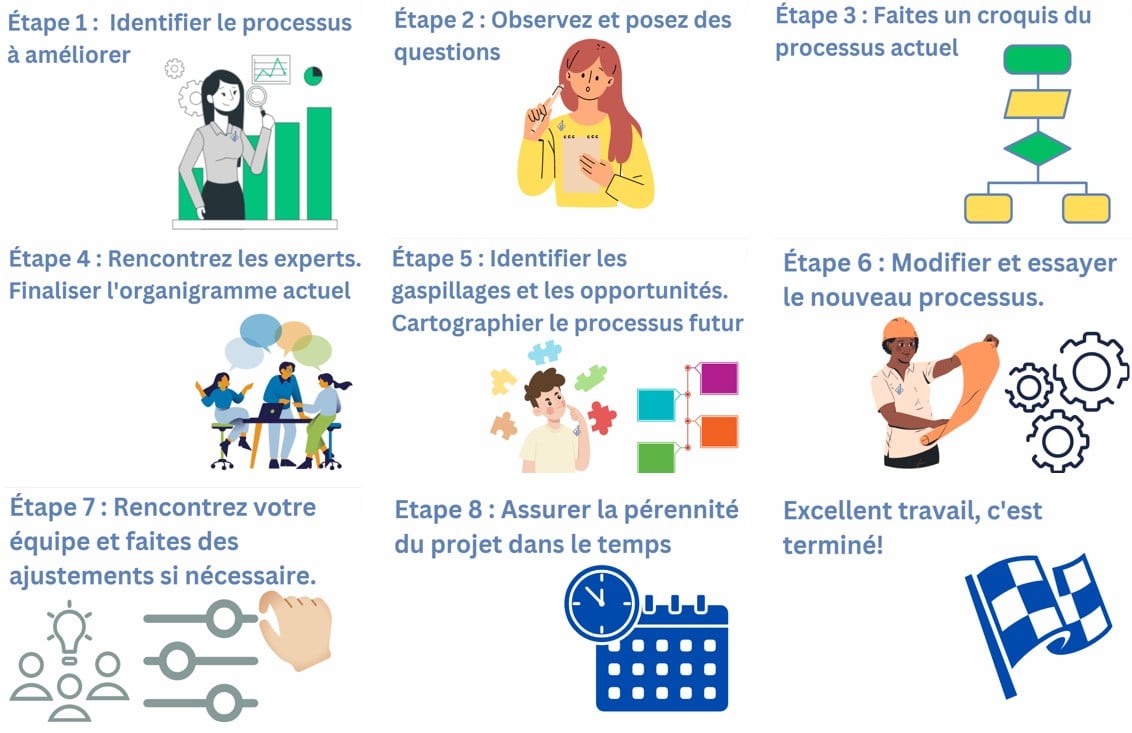Artificial Intelligence (AI) has swiftly moved from theoretical exploration to becoming a cornerstone of modern business innovation. Its journey, marked by significant advancements, has deeply integrated AI into business processes, enhancing efficiency and driving innovation.
Among its various forms, generative AI emerges as a game-changer, capable of producing novel outputs, from text to images, that revolutionize how businesses operate. This variant of AI not only streamlines operations but also unlocks new potentials for creativity and personalized customer engagement.
Its impact heralds a new era for business operations, emphasizing the importance of leveraging generative AI to maintain competitive advantage in today’s dynamic market and within industry 4.0 and 5.0.
Generative AI – A Game Changer in Business Operations
Generative AI, a subset of artificial intelligence technologies, stands out by its ability to generate new, previously unseen outputs based on its learning from vast datasets. This contrasts with traditional AI, which primarily focuses on interpreting and responding to inputs through predefined pathways.
Generative AI leverages advanced machine learning models, such as Generative Adversarial Networks (GANs) and transformers, to create content that mimics human-like qualities, offering a leap forward in how machines understand and create.
The capabilities of generative AI can be categorized into the 4Cs, as highlighted by McKinsey & Company:
- Concision: Generative AI excels at digesting large volumes of unstructured data, extracting the essence, and providing summarized, relevant insights. This capability is invaluable for tasks requiring quick understanding and decision-making from vast information sources.
- Creative Content: Beyond simple text generation, generative AI can craft complex, structured documents, design elements, and more, tailored to specific needs. Its potential for creativity is being explored in content creation, from marketing materials to product designs, showcasing its ability to innovate and personalize.
- Customer Engagement: In the realm of customer service, generative AI introduces a new level of personalization and efficiency. AI-driven chatbots and virtual assistants, powered by generative models, can guide customers through personalized journeys, enhancing the customer experience while optimizing service operations.
- Coding and Software: Generative AI is making strides in the automation of coding and software development, enabling the swift migration from legacy systems and the creation of new applications. Its capability to understand and generate code is paving the way for more efficient development processes and the potential reimagining of software design.
These capabilities underscore the transformative potential of generative AI in business operations. By automating complex processes, enhancing creativity, personalizing customer interactions, and accelerating software development, generative AI not only optimizes existing operations but also opens up new avenues for innovation and strategic advantage (McKinsey & Company, 2024).
Real-World Impact and Savings Potential
Generative AI is redefining the economic landscape of business operations, offering a staggering potential for savings and efficiency gains across various functions. According to McKinsey & Company, the adoption of generative AI technologies could unlock savings opportunities ranging from $1.4 trillion to $2.6 trillion.
This significant financial impact spans several key areas of operations, including customer service, research and development (R&D), manufacturing, supply chain management, and procurement.
- In customer service, generative AI can automate responses to inquiries and provide personalized service options, drastically reducing the time and resources required for customer support.
- In R&D, it accelerates innovation by generating new product designs and speeding up experimental simulations, leading to cost reductions in development cycles.
- Manufacturing operations benefit from predictive maintenance and optimized production planning, minimizing downtime and waste.
- In supply chain management, generative AI enhances forecasting accuracy and optimizes logistics, reducing costs associated with inventory and transportation.
- Procurement processes see improvements through automated vendor selection and contract management, ensuring cost-effective purchasing decisions.
Several companies have already harnessed the power of generative AI to drive operational efficiency and savings:
- A telecommunications company in South America utilized conversational AI for customer support, prioritizing high-value clients and promoting self-service options. This implementation led to operational expenditure reductions of approximately $80 million.
- An online learning platform introduced a gen-AI-powered assistant to streamline the onboarding process, improving the onboarding experience by 35% and demonstrating the potential of AI in enhancing employee training and development.
- In financial planning and analysis, a business leveraged a sophisticated generative AI tool to automate the synthesis of information from various sources. This resulted in more than $6 million in cost savings, showcasing the efficiency generative AI brings to complex analytical tasks.
These examples highlight the real-world impact of generative AI across different sectors, demonstrating its role in not only cutting costs but also in fostering innovation and improving service delivery.
As businesses continue to explore and implement generative AI solutions, the potential for operational transformation and savings is vast, positioning generative AI as a crucial technology for future-proofing operations and achieving sustainable competitive advantage.
Best Practices for Scaling Generative AI in Operations
To effectively scale generative AI within business operations, adopting best practices is crucial. These practices not only ensure that AI initiatives align with overarching business goals but also address the technical and human factors critical to successful implementation.
Aligning AI Strategy with Business Outcomes
A foundational step is to align the AI strategy with concrete business outcomes. This alignment ensures that AI initiatives are not pursued in isolation but are directly linked to achieving strategic objectives, such as improving customer satisfaction, reducing operational costs, or accelerating product development. Establishing clear goals helps in prioritizing AI projects based on their potential impact and feasibility, ensuring resources are allocated effectively to initiatives with the highest strategic value.
Modular Data Architecture and Automation
A modular data architecture is key to the rapid development and deployment of AI applications. By designing data systems that are flexible and scalable, businesses can more easily integrate new AI capabilities as they become available.
Automating data-related processes, such as data collection, cleaning, and analysis, further accelerates AI deployment by ensuring a consistent and high-quality data flow.
This automation is essential for feeding AI models with the data they need to learn and evolve, thereby enhancing their accuracy and effectiveness over time.
Engaging Nontechnical Employees through Low-code or No-code Platforms
The democratization of AI development through low-code or no-code platforms is a significant trend. By providing intuitive interfaces and drag-and-drop functionality, these platforms enable nontechnical employees to create and deploy AI solutions without deep programming knowledge.
This engagement not only accelerates the development of AI applications but also fosters a culture of innovation across the organization. Employees who are directly involved in operational processes can quickly build and iterate on AI solutions that address their specific challenges, leading to more relevant and impactful outcomes.
Implementing these best practices requires a concerted effort across the organization, involving leadership support, cross-functional collaboration, and continuous learning and adaptation. As AI technologies and applications evolve, so too must the strategies and approaches for scaling them within business operations.
By focusing on alignment with business outcomes, leveraging flexible and automated data architectures, and empowering employees across the organization, businesses can fully harness the transformative potential of generative AI.
Overcoming Challenges and Mitigating Risks
Adopting generative AI in business operations presents a blend of transformative opportunities and significant challenges. Overcoming these challenges and mitigating risks is crucial for organizations to fully leverage the potential of generative AI while ensuring operational integrity and trust.
Overcoming Challenges
Operational Readiness and Capability Building:
A primary concern among executives is the incorporation of generative AI into their operations, with more than 50% expressing worries about its adoption.
These concerns often stem from a lack of strategic roadmap, governance issues, and a scarcity of talent equipped to develop and implement generative AI technologies.
To address these challenges, organizations must engage in comprehensive planning, develop clear governance models, and focus on talent acquisition and development to build the necessary capabilities for generative AI integration.
Mitigating Risks
Data Governance and Security:
With the power of generative AI comes the risk of data security breaches and the misuse of intellectual property.
Businesses must prioritize robust data governance practices to protect sensitive and proprietary information.
This includes implementing strong data encryption, access controls, and ensuring that data used to train generative AI models does not expose private or proprietary information inadvertently.
Process Standardization and Model Testing:
Ensuring the reliability and reproducibility of generative AI outcomes is critical. Organizations should adopt standardized processes for data handling, model development, and testing.
By establishing clear protocols for the development and deployment of generative AI applications, businesses can improve the traceability and reproducibility of outcomes, thus reducing the risk of erroneous or unethical decision-making.
Engaging with Third-party Solutions Responsibly:
For many organizations, leveraging third-party generative AI solutions is a practical approach to harnessing this technology’s benefits.
However, this approach necessitates a careful assessment of potential risks, including errors, fraud, and loss of intellectual property.
Companies must weigh these risks against the advantages of using generative AI, implementing measures to manage and mitigate potential negative impacts effectively.
The journey toward integrating generative AI into business operations is paved with both unprecedented opportunities and significant challenges. By addressing concerns related to operational readiness, capability building, data governance, and risk management, organizations can navigate the complexities of generative AI adoption, unlocking its full potential while safeguarding their operations and reputation (BCG Global, 2023) (KPMG, 2024).
Leveraging AI for Sustainability and Talent Acquisition
In the realm of business operations, leveraging AI not only fosters efficiency and innovation but also significantly contributes to sustainability efforts and talent acquisition strategies. Understanding how these elements intertwine can provide organizations with a blueprint for more responsible and strategic AI implementation.
Leveraging AI for Sustainability
Organizations are increasingly integrating AI capabilities to enhance their sustainability initiatives. AI’s data processing and predictive analytics capabilities enable businesses to optimize resource use, reduce waste, and enhance energy efficiency, thereby minimizing their environmental footprint.
For instance, AI-driven analytics can improve supply chain logistics, resulting in reduced carbon emissions through optimized routing and inventory management. Moreover, AI tools can monitor energy consumption in real-time, identifying opportunities for savings and reducing overall energy usage in operations.
Additionally, AI technologies are being used to assess and mitigate the environmental impact of their own use. This involves developing more energy-efficient AI models and deploying AI to manage data centers’ energy use effectively, making the technology itself a part of the sustainability solution.
Such efforts align with broader organizational goals to not only leverage AI for economic benefits but also to contribute positively to environmental sustainability challenges.
Navigating the AI Talent Landscape
The surge in AI adoption has significantly impacted the talent landscape, with a growing demand for skilled professionals capable of developing and managing AI technologies.
However, sourcing, upskilling, and ensuring diversity within the AI talent pool pose significant challenges.
Strategies for Sourcing and Upskilling:
To combat talent scarcity, companies are adopting multiple strategies. These include partnering with academic institutions to access fresh talent and investing in training programs to upskill existing employees.
Upskilling programs are particularly effective, as they not only enhance the organization’s AI capabilities but also empower employees to take on more complex roles, thereby driving innovation from within.
Overcoming Diversity Challenges:
The issue of diversity within the tech field, especially in AI, remains a concern. Diverse teams are essential for creating unbiased AI solutions and fostering innovation.
To address this, organizations are focusing on creating more inclusive hiring practices, offering mentorship programs, and supporting STEM education initiatives for underrepresented groups.
By actively working to diversify their AI talent pool, companies can ensure a variety of perspectives are considered in AI development, leading to more innovative and equitable AI solutions.
Incorporating AI into sustainability efforts and addressing the complexities of the AI talent landscape are critical steps for organizations looking to responsibly and effectively leverage this transformative technology. Through strategic implementation and a focus on sustainability and talent development, businesses can harness the full potential of AI to drive both operational excellence and positive societal impact.
Summary Table of blog Post
| Section | Key Points |
|---|---|
| Introduction | Evolution of AI, its impact on businesses, significance of generative AI. |
| Generative AI – A Game Changer | Definitions, differences from traditional AI, capabilities focusing on the 4Cs: Concision, Creative content, Customer engagement, Coding/software. |
| Real-World Impact and Savings Potential | Savings opportunities ($1.4T to $2.6T) across operations, with examples of company benefits. |
| Best Practices for Scaling | Align AI with business outcomes, modular data architecture, engaging non-technical employees with low-code/no-code platforms. |
| Overcoming Challenges and Mitigating Risks | Operational readiness, data governance, standardizing processes, model testing for risk mitigation. |
| Leveraging AI for Sustainability and Talent Acquisition | Integration of AI into sustainability, strategies for AI talent sourcing, upskilling, and overcoming diversity challenges. |
| Conclusion | Necessity of a strategic and responsible approach to leveraging generative AI in business operations for future innovation and operational excellence. |
Conclusion
Embracing generative AI in business operations offers transformative potential, from boosting efficiency and innovation to personalizing customer interactions. Successfully implementing this technology hinges on aligning AI strategies with business outcomes, creating flexible data infrastructures, and empowering a broad range of employees.
Overcoming challenges such as operational readiness and data governance, while focusing on sustainable practices and diverse talent acquisition, is crucial. As businesses navigate this journey, a strategic and responsible approach to generative AI will be key to unlocking new levels of excellence and driving forward the future of business innovation.








